Practice Free AZ-120 Exam Online Questions
HOTSPOT
You have an SAP development landscape on Azure.
For each of the following statements, select Yes if the statement is true. Otherwise, select No. NOTE: Each correct selection is worth one point.


HOTSPOT
You have an SAP development landscape on Azure.
For each of the following statements, select Yes if the statement is true. Otherwise, select No. NOTE: Each correct selection is worth one point.


Note: This question is part of a series of questions that present the same scenario. Each question in the series contains a unique solution that might meet the stated goals. Some question sets might have more than one correct solution, while others might not have a correct solution.
After you answer a question in this section, you will NOT be able to return to it. As a result, these questions will not appear in the review screen.
You have a complex SAP environment that has both ABAP- and Java-based systems. The current on-premises landscapes are based on SAP NetWeaver 7.0 (Unicode and Non-Unicode) running on Windows Server and Microsoft SQL Server.
You need to migrate the SAP environment to a HANA-certified Azure environment.
Solution: You upgrade to SAP NetWeaver 7.4, and then you migrate SAP to Azure by using Azure Site Recovery.
Does this meet the goal?
- A . Yes
- B . No
A
Explanation:
We need upgrade to SAP NetWeaver 7.4 before the migration. Then Azure Site Recovery is used for
the migration to Azure.
Reference: https://docs.microsoft.com/en-us/azure/site-recovery/vmware-azure-architecture
DRAG DROP
You need to deploy an SAP production landscape on Azure. The solution must be supported by the SAP production landscape and must minimize costs.
Which Azure virtual machine series should you use for each SAP workload? To answer, drag the appropriate series to the correct workloads. Each series may be used once, more than once, or not at all. You may need to drag the split bar between panes or scroll to view content. NOTE: Each correct selection is worth one point.


HOTSPOT
You plan to deploy an SAP landscape in Azure.
You need to configure storage for the virtual machines that will host SAP Digital Boardroom.
The solution must meet the following requirements:
• Encrypt all data by using a key generated by Azure Key Vault Managed HSM.
• Support a single disk size of 50 TB and 65,000 IOPS.
• Minimize costs.
Which disk type and encryption method should you use? To answer, select the appropriate options in the answer area. NOTE: Each correct selection is worth one point.
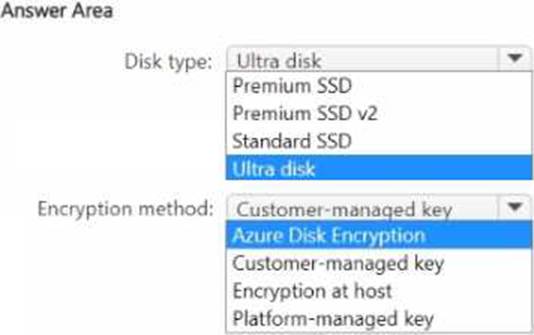
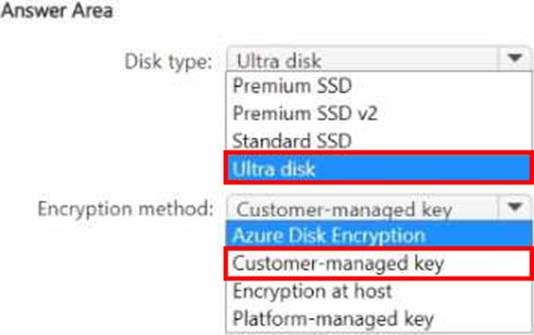
DRAG DROP
You have an SAP production landscape in Azure.
You need to recommend a disaster recovery solution that will enable failover between two Azure regions. The solution must provide the lowest recovery time objective (RTO) for a Microsoft SQL Server instance and SAP Central Services (SCS).
What should you include in the recommendation? To answer, drag the appropriate recommendations to the correct workloads. Each recommendation may be used once, more than once, or not at all. You may need to drag the split bar between panes or scroll to view content. NOTE: Each correct selection is worth one point.


HOTSPOT
You plan to deploy two Azure virtual machines that will host an SAP HANA database for an SAP landscape. The virtual machines will be deployed to the same availability set.
You need to meet the following requirements:
• Ensure that the virtual machines support disk snapshots.
• Ensure that the virtual machine disks provide submillisecond latency for writes.
• Ensure that each virtual machine can be allocated disks from a different storage cluster.
Which type of operating system disk and HANA database disk should you use? To answer, select the appropriate options in the answer area. NOTE Each correct selection is worth one point.
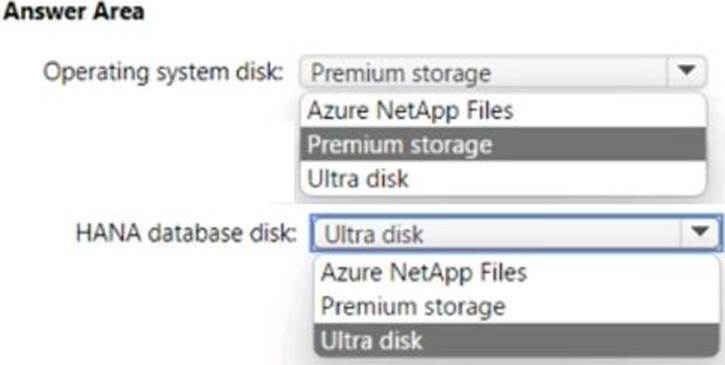
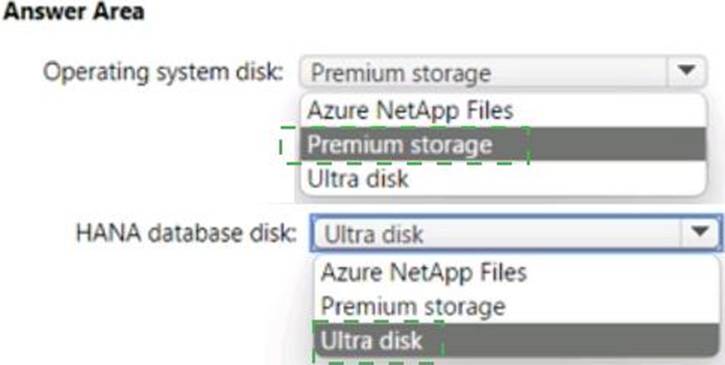
HOTSPOT
You are designing a four-node SAP Web Dispatcher deployment for an SAP on Azure landscape.
You need to recommend a resiliency solution and a load-balancing solution for the deployment.
The solution must meet the following requirements;
• Receive the highest SLA from Microsoft.
• Load balance client connections.
• Minimize administrative effort
What should include in the recommendation for each solution? To answer, select the appropriate options in the answer area. NOTE Each correct selection is worth one point.
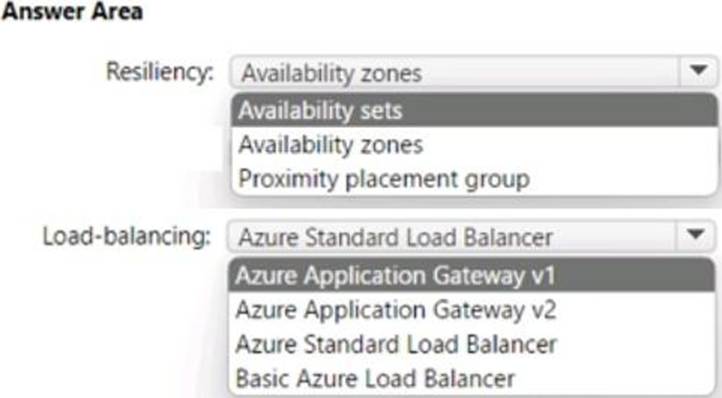
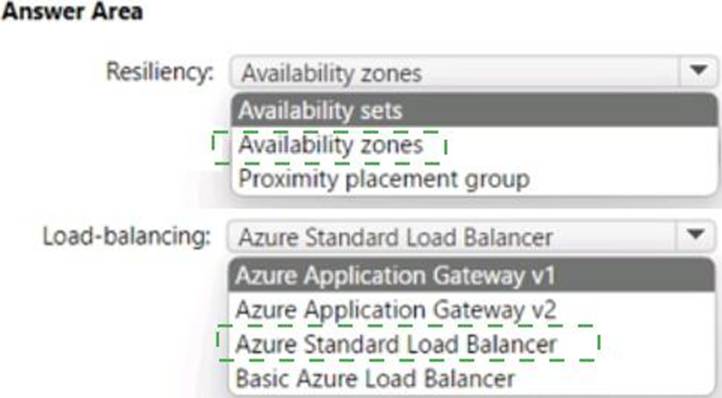
HOTSPOT
You are planning the deployment of a three-tier SAP landscape on Azure that will use SAP HANA.
The solution must meet the following requirements:
✑ Network latency between SAP NetWeaver and HANA must be minimized.
✑ An SAP production landscape on Azure must be supported.
✑ Network performance must be validated regularly.
What should you include in the solution? To answer, select the appropriate options in the answer area. NOTE: Each correct selection is worth one point.
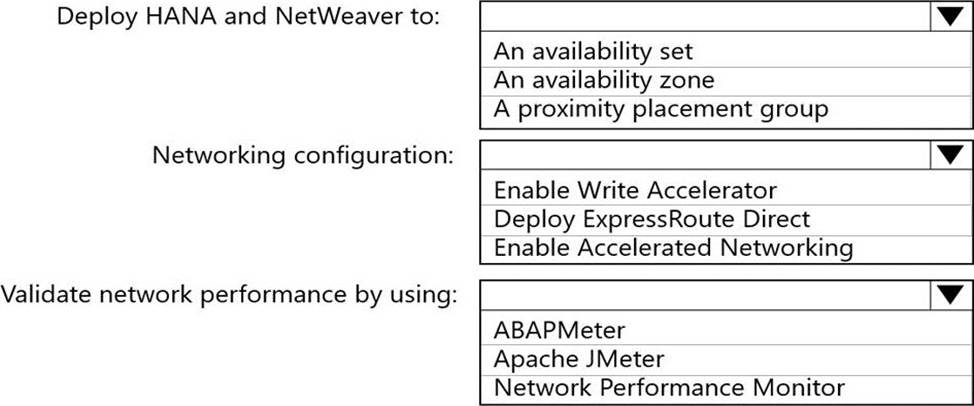
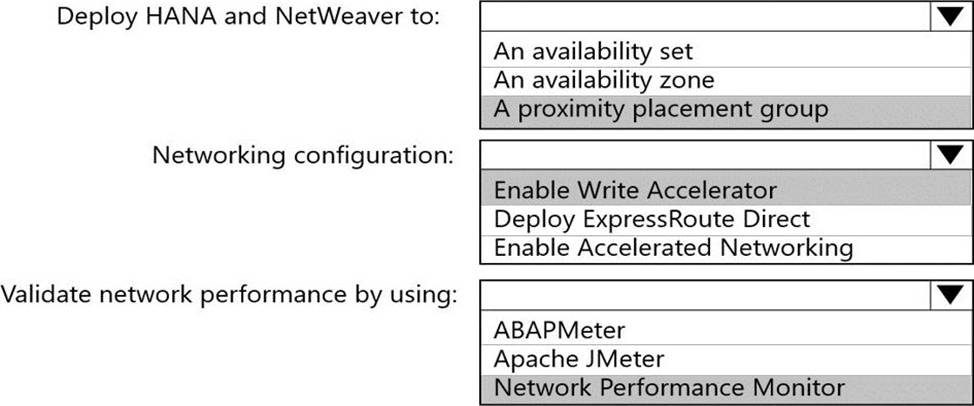
Explanation:
Box 1: A proximity placement group
Azure offers proximity placement groups. Proximity placement groups can be used to force grouping of different VM types into a single Azure datacenter to optimize the network latency between these different VM types to the best possible. In the process of deploying the first VM into such a proximity placement group, the VM gets bound to a specific datacenter.
Note: SAP applications based on the SAP NetWeaver or SAP S/4HANA architecture are sensitive to network latency between the SAP application tier and the SAP database tier. This sensitivity is the result of most of the business logic running in the application layer. Because the SAP application layer runs the business logic, it issues queries to the database tier at a high frequency, at a rate of thousands or tens of thousands per second. In most cases, the nature of these queries is simple. They can often be run on the database tier in 500 microseconds or less.
Box 2: Enable Accelerated Networking
To further reduce network latency between Azure VMs, we recommend that you choose Azure Accelerated Networking. Use it when you deploy Azure VMs for an SAP workload, especially for the SAP application layer and the SAP DBMS layer.
Box 3: Network Performance Monitor
Network Performance Monitor (NPM) – a cloud-based network monitoring solution for cloud-only, on-premises, and hybrid networking environments.
Network Performance Monitor offers three broad capabilities:
✑ Performance Monitor: You can monitor network connectivity across cloud deployments and on-premises locations, multiple data centers, and branch offices and mission-critical multitier applications or microservices. With Performance Monitor, you can detect network issues before users complain.
✑ Service Connectivity Monitor
✑ ExpressRoute Monitor
Note 2: Azure Monitor for SAP Solutions is an Azure-native monitoring product for anyone running their SAP landscapes on Azure. It works with both SAP on Azure Virtual Machines and SAP on Azure Large Instances.
Reference:
https://docs.microsoft.com/en-us/azure/virtual-machines/workloads/sap/sap-proximity-placement-scenarios
https://docs.microsoft.com/en-us/azure/virtual-machines/workloads/sap/dbms_guide_general
https://techcommunity.microsoft.com/t5/running-sap-applications-on-the/sap-on-azure-general-update-march-2019/ba-p/377456
HOTSPOT
You have an SAP production landscape on Azure that contains the virtual machines shown in the following table.

You configure HANA system replication as shown in the following table.

You configure two load balancers as shown in the following table.

For each of the following statements, select Yes if the statement is true. Otherwise, select No. NOTE: Each correct selection is worth one point.


Explanation:
Reference:
https://help.sap.com/viewer/6b94445c94ae495c83a19646e7c3fd56/2.0.02/en-US/f730f308fede4040bcb5ccea6751e74d.html
https://docs.microsoft.com/en-us/azure/virtual-machines/workloads/sap/sap-hana-high-availability
